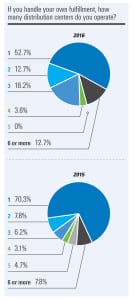Continuing growth in ecommerce is fueling a tight market for distribution and fulfillment centers space, either leased, purchased or through a partner, as companies look to expand their networks to meet growing consumer demand for rapid parcel delivery.
According to commercial real estate firm CBRE, there was 220 million square feet of net absorption of industrial/logistics real estate space in the U.S. in 2015, of which 50% to 75% comprised warehouses. This is compared to 150 million square feet of new supply, making the market the tightest it’s been in years.
[Get news like this delivered to your inbox every week. | Subscribe to O+F Advisor today!]
And CBRE’s most report on the U.S. industrial and logistics space market finds the availability of industrial warehouse space fell to 8.8% in Q2, down from 9% in Q1, marking the 25th straight quarter of decline.
“While the gap is narrowing, demand is still outpacing supply by a lot – it’s out of whack,” said David Egan, head of industrial research, Americas at CBRE. “The reason is primarily ecommerce. Demand has been really good, frankly a lot better than people expected, and the supply side can’t keep up.”
This trend is reflected in Multichannel Merchant’s MCM Outlook 2016 report (see graphic, click to enlarge). The number of survey respondents who said they operated a single DC dropped from 70.3% in 2015 to 52.7% in 2016, while those with two increased from 7.8% to 12.7%, and those with 3 DCs nearly tripled from 6.2% to 18.2%. At the high end, those with six or more DCs increased from 7.8% in 2015 to 12.7% in 2016.
“Demand for fulfillment centers continues to grow, largely because consumers today are more mobile than ever and have the ability to buy anytime from anywhere,” said Ryan Kelly, vice president of strategy and communications for GENCO, a unit of FedEx.
According to Forrester, ecommerce growth is projected to grow $373 billion this year to more than $500 billion by 2020. “As a result, fulfillment center demand is expected to stay strong for ecommerce,” Kelly said. “In conjunction with online sales growth, two-day delivery expectations are driving the need for more regionalized, multi-client fulfillment centers, as opposed to large, centralized distribution centers.”
Taras Kowalczyn, vice president of operations at Potpourri Group, said his company is close to opening a new DC near its current one in Littleton, MA outside of Boston, after a fruitless search for an existing facility in a number of markets.
Some of the places the company looked include Memphis, Columbus, OH, Annapolis, MD, Atlanta and Las Vegas, although the search went very broad. In Memphis, for example, all the available buildings were too large for its needs. And in almost every area, he said, an extremely tight labor market was a limiting factor.
“The reason we decided to go greenfield is we couldn’t find a DC anywhere that met all our fulfillment needs and specifications,” Kowalczyn said. He added Potpourri did have a pretty demanding list of requirements, including 800 parking spaces to handle the temp workforce at peak, a 500,000-square-foot facility and 32-foot clearance for its mezzanines.
Kowalczyn said the build option was not the first choice, given the long lead time of two years. “But it became evident early on in the process that it was our only choice,” he said.
Egan said access to major populations and transportation networks were the two primary drivers of DC demand. Some of the hottest markets currently are Los Angeles, Chicago and Miami-Dade, as well as the Lehigh Valley in Pennsylvania and the so-called “inland empire” east and north of Los Angeles.
“Dallas and Atlanta are also major markets right now,” he said. “In the next tier, Kansas City has grown quite a bit, as well as Memphis, Louisville and Cincinnati, all with good access to Midwest populations and in or close to major carrier hubs.”
Markets with the largest declines in commercial space availability in Q2, according to CBRE, were West Palm Beach, FL, Newark, NJ, Memphis, TN, Tampa, FL, Jacksonville, FL and Detroit, MI. According to CBRE, Houston, TX, Cincinnati, OH, Denver, CO, Minneapolis, MN, Riverside, CA, south central Pennsylvania, Cleveland, OH and Honolulu, HI all saw higher availability rates as development started to catch up with demand.
Jeff Havsy, chief economist, Americas for CBRE, said he wouldn’t be surprised to see vacancy rates for industrial space, including distribution and fulfillment centers, start to tick up in the near future as supply starts to catch up with demand.
“It doesn’t mean the demand’s going away,” he said. “Availability could increase even though fundamentally we’re still in good shape.”
Mike O’Brien is Senior Editor of Multichannel Merchant

